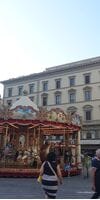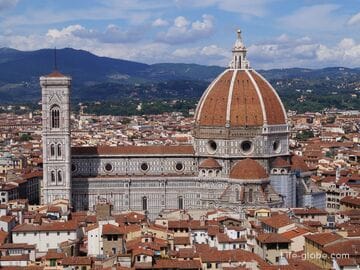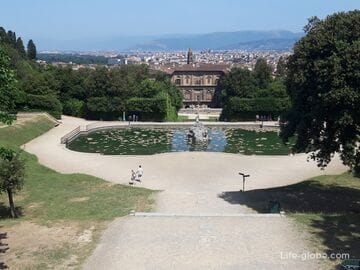Republic Square (Piazza della Repubblica) is one of the main and most visited squares in Florence, with the famous arch and column of Plenty, as well as the Tuscan carousel and cafe.
Piazza Repubblica is located in the historic center of Florence.
It was the main commercial square of Florence; and, together with the other two squares, the religious center of Florence, the Duomo Square and the center of the political and social life of the city, the Piazza della Signoria, are the trio of the heart of Florence.
View of Republic Square from the observation deck of the Giotto Bell Tower in FlorenceInitially, the Roman forum was located on the site of the square.
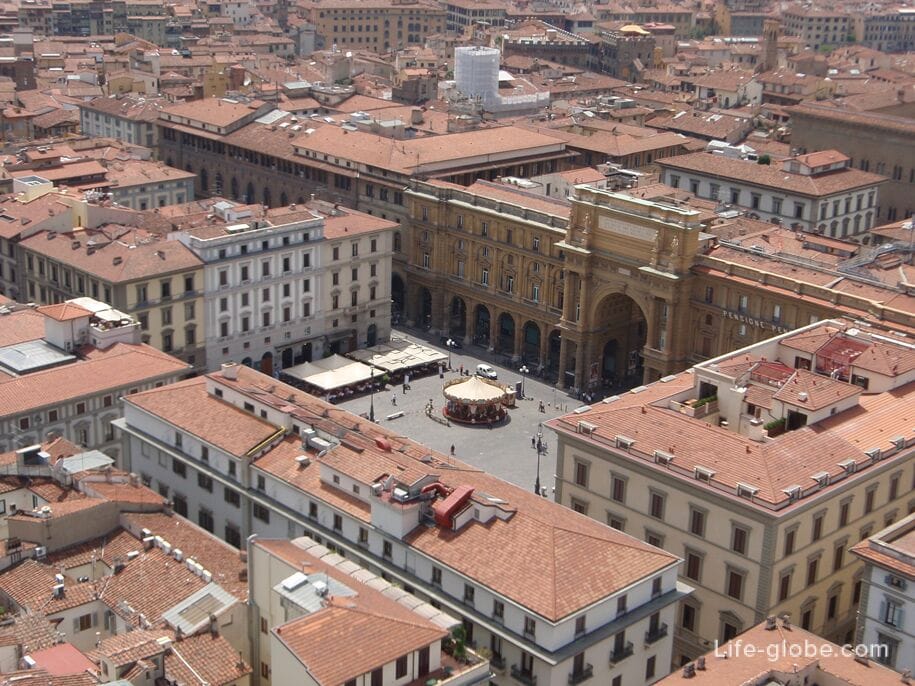
During the early Middle Ages, the territory of the forum was densely populated, and there was an Old Market (Mercato Vecchio, Mercato Vecchio) with a Fish loggia (Loggia del Pesce, Loggia del Pesce).
The square received its current appearance as a result of urban planning, after the proclamation of Florence as the capital of Italy (1865-1871), with particularly intensive activity on the square between 1885 and 1895.
On September 20, 1890, the equestrian monument to Vittorio Emanuele II (Equestrian monument to Vittorio Emanuele II) was opened on the square, from which the square was then named Piazza Vittorio Emanuele II (Piazza Victor-Emmanuel II). In 1932, the monument was moved to the Cascine Park in Florence (Parco delle Cascine).
After the war, the square got its current name - Republic Square.
Today, this rectangular square is one of the centers of Florence. It is surrounded by buildings and, on the one hand, the famous arch called the Arcone.
In the buildings around the square there are cafes, restaurants, shops and accommodation facilities (hotels, apartments)
The center of the square is decorated with a tall column of Abundance.
Also on the square there is a bright carousel, which is called the Old Tuscan Carousel (Antica Giostra Toscana), as well as souvenir shops, artists and street performers.
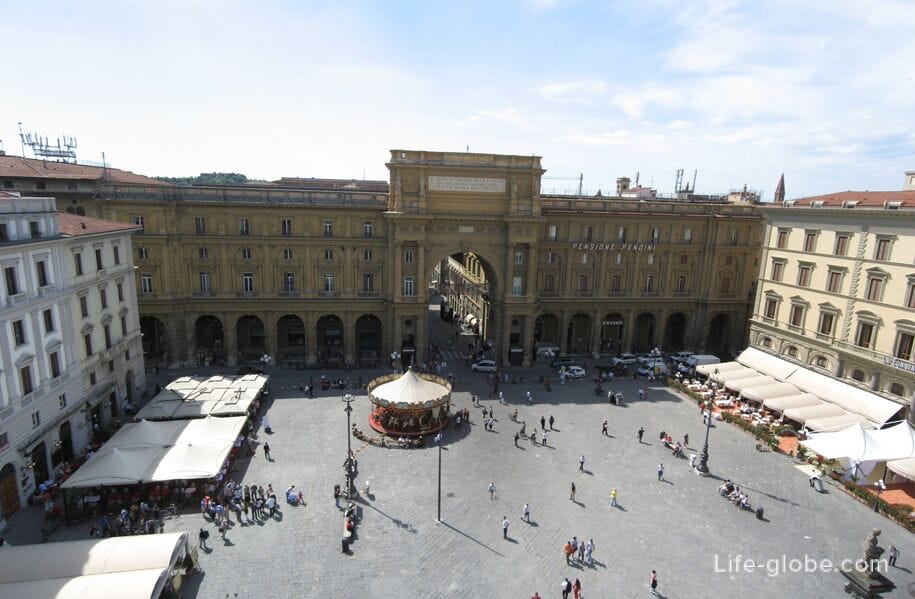

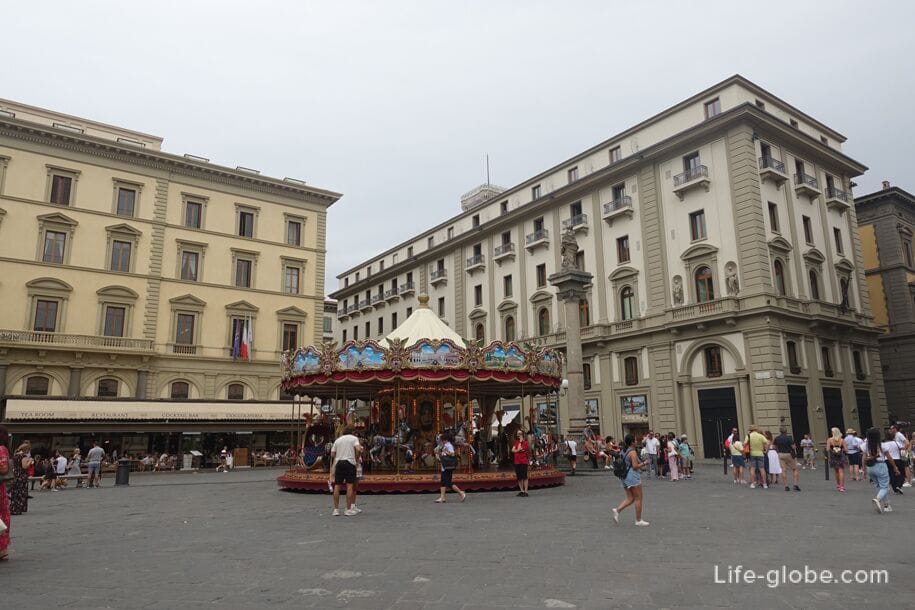
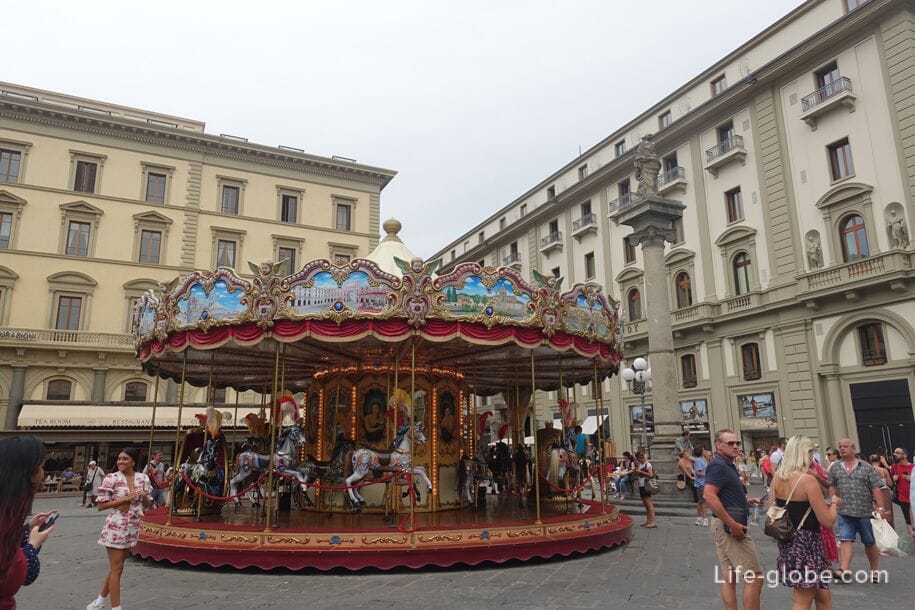
Video of street performers on Republic Square
The Column of Plenty (Colonna dell'Abbondanza, Colonna dell'Abbondanza) is a tall monumental column.
The column of gray granite from the Elbe was originally erected in 1430-1431 by local civil servants. At the top was placed a statue of gray-blue sandstone by Donatello, depicting the allegory of Dovizia (Abundance) with a cornucopia in his hand, which corresponded to the theme of the market located here.
At that time, two chains were attached to the column: one for the bell at the top, which was rung to announce the opening and closing of the market, and the other at the bottom with a collar and bell, which were used to chain dishonest merchants, fraudsters and insolvent debtors for public shame.
The dilapidated statue was removed from the column in 1721 and replaced with a marble statue by Giovanni Battista Foggini. During the clearing of the square between 1885 and 1895, the column was dismantled, and its parts were preserved in different places.
In 1956, under the supervision of engineer Giulio Cesare Lenci Orlandi Cardini, the column was reassembled with a bronze replica of the Foggini statue by Mario Mosca.
Today, the column on Republic Square is located about two meters from its original location.


On the western side of the square, a massive arch (Arkone) with arcades is notable, which in the Middle Ages served as an entrance/ exit.
The arch was created by Vincenzo Micheli. Then it was changed and expanded on each side with galleries with columns.
Once on the top of the Arcone there was an allegorical group of plaster with three women who symbolized Italy, Art and Science. But the Florentines themselves gave three female sculptures the names of famous prostitutes of that time: Starnotti, Chipiscioni and Trattiengi. The sculptures were removed in 1904.
The arch is decorated with columns and sculptural. At the top of the arch is the inscription: "The ancient city center, restored from centuries of squalor to a new life" (L'ANTICO CENTRO DELLA CITTÀ / DA SECOLARE SQUALLORE / A VITA NUOVA RESTITUITO).

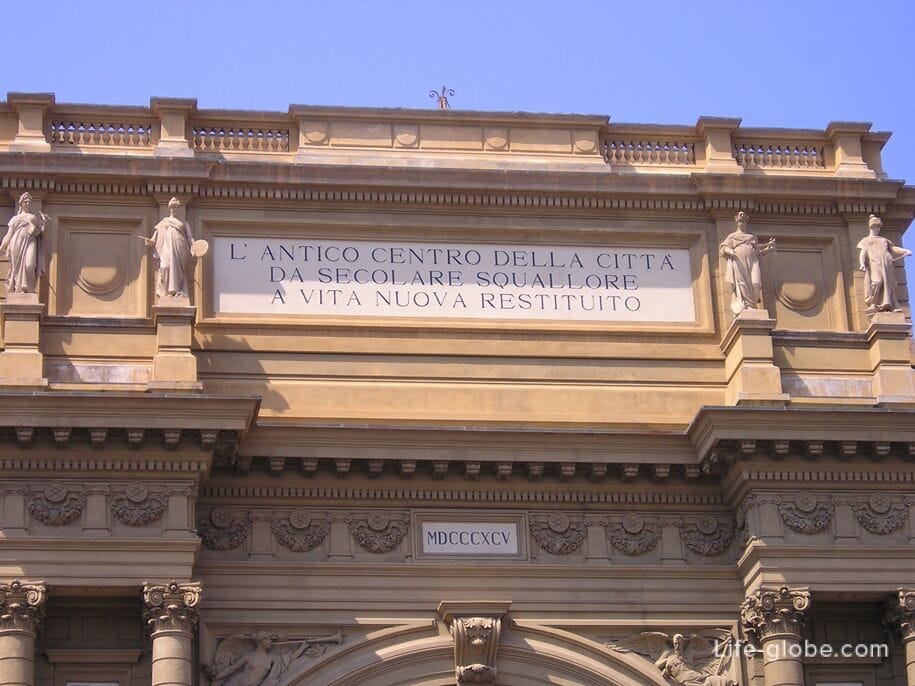
The south side of Republic Square consists of one long building, which houses the historic cafe "Giubbe Rosse".
On the north side of the square there is also one large building, on the ground floor of which there are two cafes with tables in the open air.
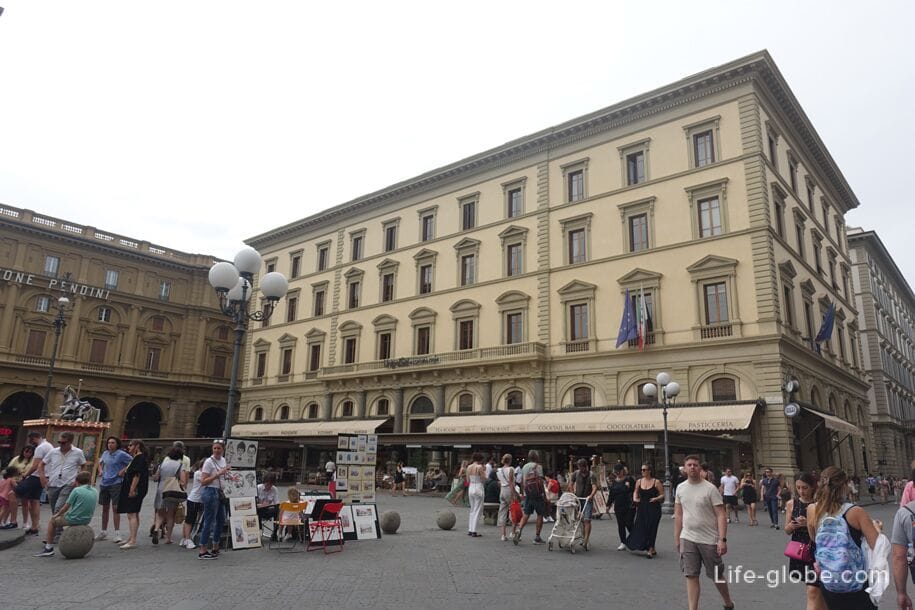
The eastern side of Republic Square is formed by two buildings, between which the via degli Speziali Street runs.
The building on the left is the famous 5-star Hotel Savoy (Rocco Forte Hotel Savoy), built by Vincenzo Micheli with an eclectic style facade.
The hotel has a restaurant, bar, fitness center, private parking and free Wi-Fi.
The rooms and suites of the hotel are decorated in the tradition of Italian design, decorated with artwork themed by local fashion houses.
The rooms and suites are equipped with air conditioning, mini-bar, coffee machine, safe, flat-screen TV, satellite channels and pay-per-view channels, hairdryer, slippers, bathrobes. Many rooms offer views of Republic Square, the Giotto Bell Tower or the dome of the Duomo Cathedral.
Breakfast may be included in the room rate. Link to the hotel

Also near the Republic Square you can highlight Palazzo Vecchietti - Residenza D'Epoca, housed in a 16th century building designed by the sculptor Giambologna and belonged to one of the most influential families of medieval Florence.
The noble family after whom this exquisite historical building is named is mentioned in Dante Alighieri's famous literary masterpiece.
Today it houses exclusive suites, suites with terraces and apartments.
Breakfast is included in the price of rooms and apartments. Link to the hotel
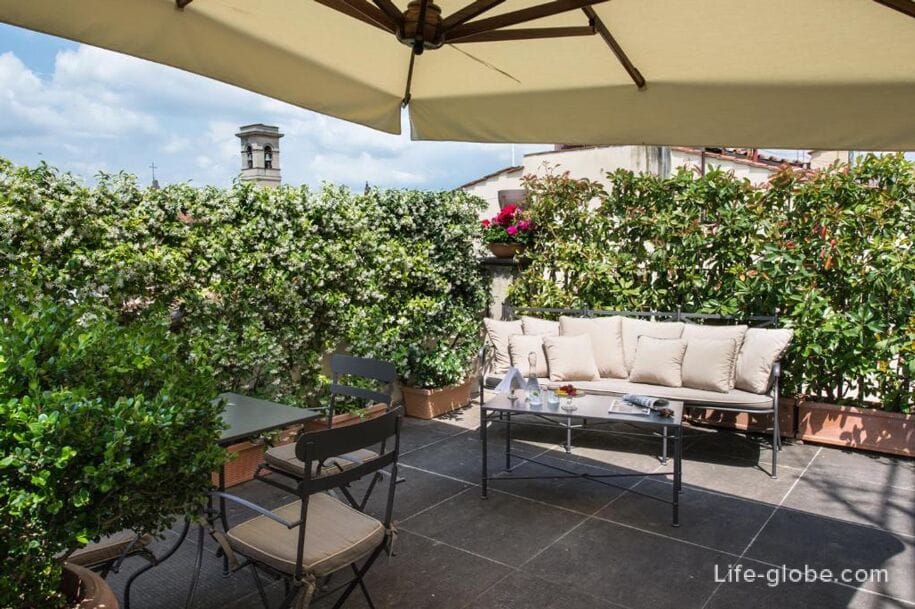
Loggia of the former market on Republic Square
From the Old Market, which was once located instead of the Republic Square, the Pesci Loggia or Fish Loggia (Loggia del Pesce) has now been preserved, which was built by the Tuscan architect Giorgio Vasari by order of Cosimo I de' Medici in 1567 to move fishmongers to the loggia, which was previously located next to the Vecchio Bridge.
Around 1885-1895, the loggia was dismantled from its original location, and its architectural elements, weapons, fish medallions and busts, ended up in the lapidary factory of the National Museum in the Monastery of San Marco, with many other ancient elements of the Old Market.
In 1956, the Committee of Urban Aesthetics decided to restore the loggia, simultaneously with the restoration of the column of Plenty. For which the original materials that were preserved were used, but the location of the loggia was changed and today it is located on Piazza dei Ciompi in Florence.
The loggia has nine open arches with pilasters and columns. Eight medallions decorating the loggia remind of the sea, fishing and related activities in accordance with the original function of the market. The corners of the loggia are decorated with four coats of arms, and the cartouche in the center of the large facades recalls the Grand Ducal Commission.
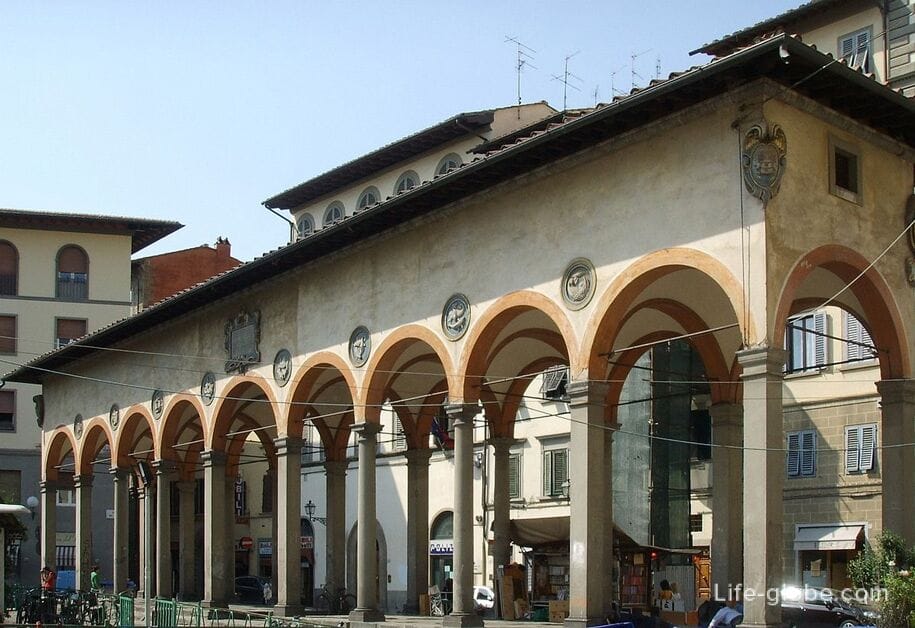
The Old Market, called "Old" after the construction of the New Porcellino Market in Florence, was an important place of trade and life of the townspeople. And it is not surprising that many legends associated with Florence originate from this square.
According to one such story, in 1245 Saint Peter the Martyr preached in the market in front of a large crowd, then the devil, who wanted to stop him, took the form of an impressive black horse, raced through the market and tried to crush the listeners. But, realizing the impending danger in time, Saint Peter raised his hand and crossed the horse, which suddenly stopped and disappeared. Several centuries later, in memory of this event, Bernardo Vecchietti commissioned Giambologna to create a bronze standard-bearer in the form of a little devil, which Vecchietti placed on the corner of his palace between Vecchietti Street and Strozzi Street.
The sculpture of the little devil can still be seen today on the corner of the house at the address: Via degli Strozzi, 12/18 R, 50123 Firenze FI, Italy.
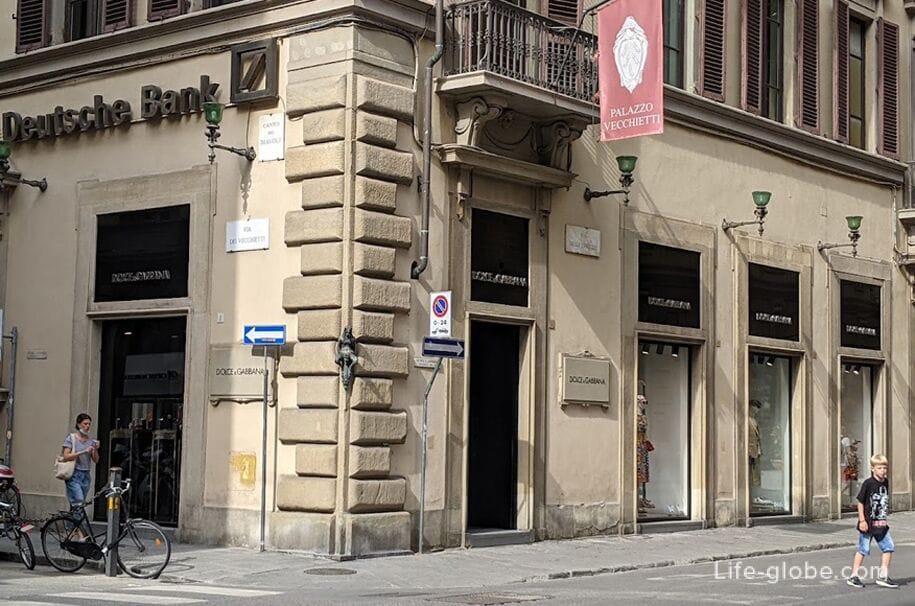
Practical information
Republic Square is available for visits 24 hours a day.
Coordinates of the Republic Square in Florence: 43°46'17.0"N 11°15'14.0"E (43.771389, 11.253889).
All accommodation facilities in Florence (hotels, apartments, guest houses, etc.), including those in the historic city center, near Piazza della Repubblica and more remotely from those, can be view and book here




